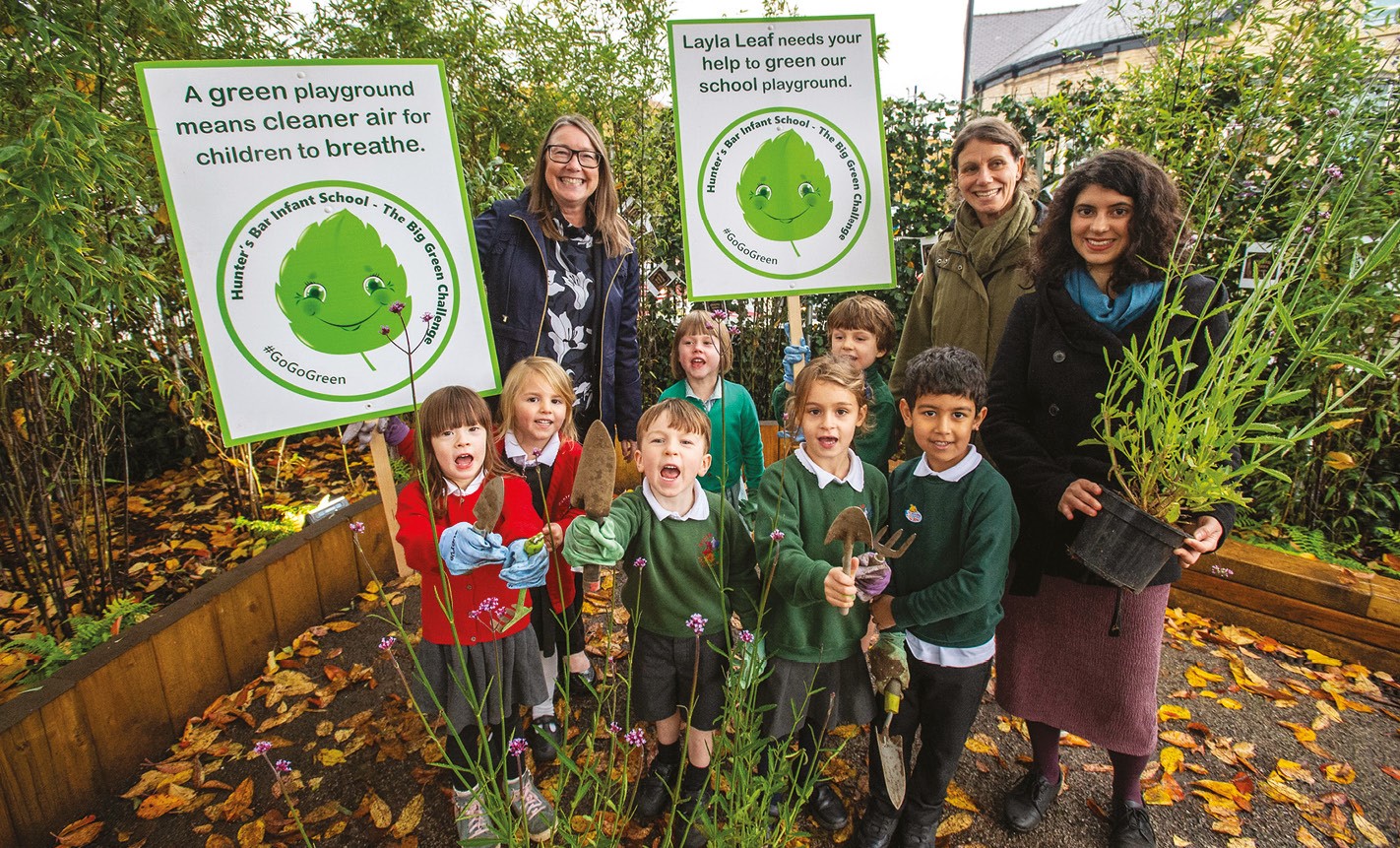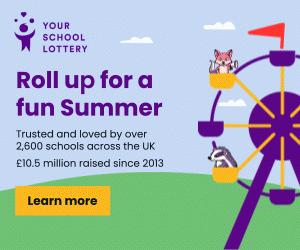‘Our #GoGoGreen barrier project helped clean up the air’
In 2017 we embarked on a scheme to green our school and improve the air our children breathe. Our PTA, known as the Home School Association (HSA), had been raising money for the next environmental project following the successful installation of solar panels on the school roof. Teachers, parents and the school’s Green Team (a pupil-based club) had asked to plant up the concrete yard. We’d also been monitoring our air quality because of our location next to a roundabout on one of the main roads in Sheffield. During one particular governors’ meeting the headteacher was reporting on nitrogen dioxide (NO2) levels in the playground, and it was noted that the school had exceeded the World Health Organization’s recommended limit of NO2 for two consecutive months.
I met with Sheffield City Council, who told me about schools in London that had produced a green wall using ivy and other plants to improve the air quality within their school. The school governors reviewed these case studies and we started talks with the University of Sheffield about the potential for a before and after air quality research project. This culminated in the successful appointment of PhD student Maria del Carmen Redondo Bermúdez and her project: Breathe – A feasibility study of green barriers to mitigate air pollution in school playgrounds.
My role was to manage the project timeline for the school, chair meetings, write updates, track actions, budgets and procurement, as well as produce and deliver the corporate partnerships strategy, business relationships and public relations.
I created a sponsorship pack, press releases, promotional assets and developed the #GoGoGreen campaign. The whole school community fundraised tirelessly. This included dedicated events such as the park fun run (raising £3,000) and a David Bowie tribute concert (raising £4,000). Local businesses sponsored sections of the plant-based green wall. And our partnership with Sheffield Business Together and bigger businesses, including developers Henry Boot, engineers Arup and landscape architects Urban Wilderness, delivered the groundworks, landscape designs and planting schedules.
The main element of the barrier is an ivy fence: 50 panels of pre-grown ivy were installed by parents around the entire 60-metre perimeter of the schoolyard. In front of them, parents, pupils and volunteers from across the city planted 230 plants in newly created beds.
The plant species were chosen by Maria because they do different things. The ivy climbers can capture particles and reduce NO2, as they act as a physical barrier to pollution from the street. Then there are conifers and bamboo. These are plants that grow fast and provide a physical barrier to pollution, and can also catch particulates (tiny particles of air pollution) on their leaves and bark.
In total the school raised over £22,000 from fundraising and sponsorship efforts, and we also received around £50,000 worth of in-kind support from businesses who donated their time, people and products.
We really pushed the boat out because we were part of the study with Maria and the university and because we wanted to raise awareness of what we were doing and why, but a green barrier to mitigate against air pollution could be achieved on a reduced budget too.
Our long-term vision was to develop a digital toolkit to benefit other schools, and Maria and I invested a lot of time capturing the journey to support others. But then Covid hit and we’ve all had to prioritise other things in the immediate term. We still regularly speak to people about the project and the school is always happy to show people around and share learning. Maria is still collecting data as her study had to be extended and amended to accommodate the impact of Covid on traffic levels and the way the school community interacted with the space. Maria has been incredible to work with and we look forward to her being published and receiving her PhD.
The big difference we have seen as a school community is the impact on the pupils. They’ve been involved in air quality testing, planting and looking after the plants. Our playground is quieter and safer. The ivy has grown so thick now and the yard looks more like an outside forest school classroom! Quite different from how it used to feel on this busy Sheffield road.
Rowan Hall, school governor, Hunter’s Bar Infant School, Sheffield (270 pupils)
‘We planted trees to make the school look beautiful’
Our school initially applied for trees from the Woodland Trust’s Free Trees for Schools and Communities Scheme in October 2020, and asked if the Parent Staff Association (PSA) could help organise an event to get them in the ground. Delivery was delayed because of Covid, and we eventually held our tree planting day last May.
We started planning the event at the end of a lockdown. Parents hadn’t been allowed past the school gates for months. I’d always wanted to hold community events as well as fundraisers, and I saw this as an exciting opportunity to encourage everyone back into the grounds.
Our school site is relatively new, having been rebuilt in 2015, and the school were keen to use the trees to create a privacy screen in an under-utilised green area. But there’s another reason for our focus on plants – our proximity to The Royal Botanic Gardens at Kew. As co-headteachers Voulla Demetriou and Jenny Stroud-Turp explained in their joint statement: ‘Being located in the heart of Kew, learning about plants plays an important part in our science and art curriculum.’
We planted the trees on a beautiful sunny day. Members of staff set the tables up, and the PSA organised the workforce. Some people brought their own spades and we set out extra tools and trees, and made tags for the children to write their names on. Our local Sainsbury’s donated activity kits containing a selection of items including a magnifying glass that the children could use to explore the earth.
The PSA also provided an ice-cream van to draw the children in and keep the parents topped up with teas and coffees. At that time on a Saturday, there’s a football club on our AstroTurf pitch, so they got extra business from those parents too. The PSA made ten per cent of all sales.
The kids had a wonderful time getting their hands dirty. My son put himself in charge of the water – he was only six at the time, but he worked really hard and filled up all the watering cans. We allocated a separate space to a family who were shielding so they could participate too.
Everyone loves seeing the trees and watching them grow. ‘The trees will benefit the children of today and the future, through increasing oxygen, combating pollution and providing a green space to play in,’ say our co-chairs.
Rebecca Geitgey, PSA chair, Queen’s CofE Primary School, Kew (400 pupils)
‘Our outdoor instruments add an extra dimension to playtime’
The school tends to take the lead on big proposals, and when the PTA suggested a big, stand-alone project, they asked for large outdoor musical instruments to enhance the playground.
We applied to the Co-op Local Community Fund after hearing about it from a local playgroup. We were chosen as one of their causes and eventually awarded over £9,800. To the delight of all involved, the instruments were installed over the next few months by Percussion Play and Playdale.
We have five instruments in the playground: samba drums, a wooden xylophone bench, cowbells, chimes and drums. We also have smaller pieces that can be brought out if the children want to use them.
During Covid restrictions we had six bubbles and divided the playground up to restrict contact. Our outdoor instruments gave pupils a way to express their feelings.
Louanne Roberts, PTA treasurer, St Aidan’s C of E Academy, Skelmanthorpe, near Huddersfield (180 pupils)





